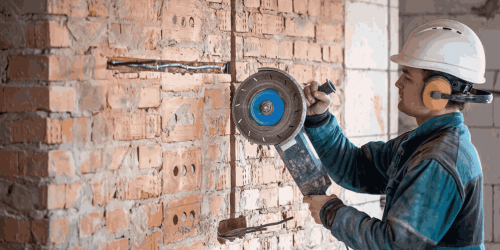Concrete removal is a significant undertaking, whether you’re renovating your home, upgrading infrastructure, or preparing for new construction. It involves more than just breaking up and hauling away old concrete; factors like the type of concrete, its location, and the method of removal all influence the overall cost. Typically, professionals assess these variables to provide accurate estimates, ensuring you understand the financial implications before proceeding. The expense of concrete removal varies widely based on several factors. For instance, the size and thickness of the concrete slab or structure play a crucial role in determining the labor and equipment needed. Accessibility to the site and environmental considerations also affect costs. Furthermore, the disposal method—whether recycling or landfill—impacts overall expenses and environmental sustainability. By comprehending these factors, you can better plan and budget for your concrete removal project, ensuring efficiency and cost-effectiveness in achieving your desired outcome.
Removing concrete is a significant undertaking that involves various costs depending on several factors. Whether you’re renovating your driveway, demolishing a building, or making space for new construction, understanding these costs can help you budget effectively and make informed decisions. In this article, we’ll delve into the basics of concrete removal costs, exploring the key factors that influence pricing and providing insights into how you can manage these costs efficiently.
The type of concrete plays a crucial role in determining removal costs. For instance, reinforced concrete, which contains metal reinforcement bars (rebar), is typically harder to break down and remove compared to plain concrete. This increased difficulty often translates to higher labor and equipment costs. Similarly, decorative concrete with patterns or special finishes may require more careful handling during removal, affecting both time and cost.

The thickness and volume of the concrete directly impact removal costs. Thicker slabs or larger volumes require more time, effort, and equipment to break apart and haul away. Contractors often charge based on square footage or cubic yards of concrete removed, so accurately measuring these dimensions is essential for estimating costs.
The accessibility of the concrete removal site influences costs significantly. If the concrete is located in a hard-to-reach area or requires specialized equipment to reach, such as in backyard projects or urban environments with limited space, contractors may need to allocate more resources, which can drive up costs.
The method used to demolish the concrete also affects costs. Common methods include jackhammering, saw cutting, and using heavy machinery like excavators. Each method has its own cost implications in terms of equipment rental, labor requirements, and disposal logistics. Contractors will assess the best method based on site conditions and project goals to optimize efficiency and minimize costs.
Disposing of concrete responsibly involves additional fees. Many areas have regulations governing the disposal of construction debris, including concrete, which may include landfill fees or fees for recycling facilities. Contractors often factor these fees into their quotes, so understanding local disposal regulations and options can help you plan for these costs.
Concrete removal is not just about breaking down and hauling away material; it also involves considerations of environmental impact and sustainability. Understanding these factors is crucial for managing costs effectively while ensuring responsible disposal practices. In this article, we explore how environmental considerations influence concrete removal costs, providing insights into regulations, recycling benefits, and eco-friendly practices that can impact your project’s budget.
Environmental regulations govern the disposal of concrete and construction debris in many regions. Compliance with these regulations often involves obtaining permits, adhering to specific disposal methods, and potentially paying fees for environmental assessments or certifications. Non-compliance can result in fines or delays, making it essential to factor regulatory requirements into your project’s budget.
Recycling concrete offers significant cost benefits and environmental advantages. Instead of disposing of concrete in landfills, recycling facilities can process it into aggregate for new construction projects. Recycling reduces disposal fees, conserves natural resources, and minimizes carbon emissions associated with transportation and processing of raw materials. Many contractors offer recycling options, and choosing recycled concrete can be cost-effective compared to traditional disposal methods.
Disposing of concrete responsibly often involves fees that vary by location and disposal method. Landfill fees, recycling charges, and fees for hazardous waste disposal (if applicable) can add up quickly. Understanding these costs upfront allows you to budget accordingly and explore cost-effective disposal options such as recycling facilities or municipal waste management programs that offer reduced fees for recycled materials.
For larger projects or those in environmentally sensitive areas, conducting environmental impact assessments may be necessary. These assessments evaluate potential impacts on air quality, water resources, wildlife habitats, and cultural resources. Costs associated with assessments vary based on project scope and regulatory requirements but are essential for ensuring compliance and mitigating environmental risks.
Using eco-friendly demolition techniques can reduce environmental impact and associated costs. Methods such as selective demolition, which salvages reusable materials and minimizes waste, can lower disposal fees and contribute to sustainability goals. Employing dust suppression measures and noise reduction techniques during demolition also enhances environmental stewardship while potentially reducing project costs related to cleanup and community relations.
Budgeting for concrete removal involves careful planning and consideration of various factors to ensure the project stays within financial constraints. Whether you’re tackling a small residential job or a large commercial demolition, these tips will help you manage costs effectively and avoid unexpected expenses.
Understanding the costs associated with concrete removal is crucial for making informed decisions about your construction or renovation projects. Whether you’re dealing with a small backyard patio or a large commercial site, factors like the volume of concrete, accessibility, disposal fees, and labor costs can significantly impact your budget. By working with professionals like JUNKAHAULICS in Raleigh, you gain access to expertise that ensures the job is done efficiently and within your financial expectations.
At JUNKAHAULICS, based in Raleigh, we specialize in concrete removal and disposal services tailored to meet the unique needs of our clients. Our experienced team is dedicated to providing transparent pricing and exceptional service from start to finish. If you have any questions about concrete removal costs, or if you’re ready to schedule a consultation, don’t hesitate to reach out. Contact us at 919-478-4814 to discuss your project requirements and discover how we can assist you in achieving your construction goals seamlessly.


JUNKAHAULICS